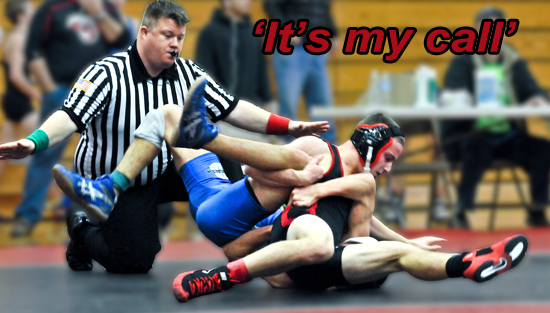Kyle Berger, a former coach and wrestler at North Penn High School, is a PIAA wrestling official who will be contributing bi-weekly columns.
 By Kyle Berger
By Kyle Berger
“What’s the top guy doing?”
“Make ‘em wrestle!!!”
“Stalllllll-ing!”
These might be the three most popular things wrestling coaches and fans shout out to the referee during matches. And with good reason – stalling is the biggest problem in the sport today.
It is expected that wrestlers give their best effort for the full six minutes of a match, but too often, that is not the case. It’s unfortunate because there is not a sport out there that can match the intensity, physicality, and mano a mano theater of wrestling.
I feel one of the reasons that wrestling dual meets aren’t standing-room-only affairs like they were when I was young is that there simply isn’t enough action on the mat. Too many wrestlers stall to avoid action, and not enough stalling calls are made by officials.
If a wrestler is winning in the third period, chances are he will coast to the finish and not take too much initiative to open up the action. That’s stalling.
If a wrestler is sent out in a dual meet against a far superior wrestler, chances are his coach will tell him to stay away and not get pinned. That’s stalling.
If a wrestler is leading by one point with 30 seconds to go and he is in the top position, chances are he will ride his opponent out without attempting to turn him for back points. That’s stalling.
But here’s the inherent problem. Stalling is the most subjective rule in just about any sport.
Most sports’ rules are very black-and-white: Did the ball cross the plane of the goal line? Did the runner get his hand underneath the tag at second base? Who touched the ball last before it went out of bounds?
Stalling is almost completely left up to the interpretation of the wrestling official. The only cut-and-dry definition of stalling in the rulebook is when an offensive wrestler “legally holds the heel to the buttocks while the defensive wrestler is broken down to the mat for more than five seconds.” (That’s rule 7-6, Article 4, paragraph B for you rules junkies out there).
There are ten other examples of stalling in this section of the rulebook, all of which allow some leeway to the official as to whether or not to warn a wrestler for stalling. These range from a wrestler not actively attempting to secure a takedown in the neutral position to riding parallel on offense to “clamming up” on defense.
One of the things I’ve tried to improve upon the most as a wrestling official (I’m in my fourth year now) is to be much more aggressive in calling stalling against wrestlers who are not making an effort to score points.
But how do you know when a wrestler is intentionally not trying to wrestle as opposed to being unable to do anything due to a superior opponent? That’s a challenge to all officials, and those decisions to call (or not call) stalling are given the most scrutiny by coaches and fans.
I tend to draw on my experience from my days as a high school wrestler when making (or not making) these calls. When I wrestled, I always tried to be the aggressor in the match and earned many points because my opponent would be called for stalling. I feel that the wrestler making the best effort should be rewarded thusly.
When I talk to teams prior to a dual meet, I always emphasize to them the responsibility each wrestler has to always do his best to score points from any position on the mat. I warn them that I will not hesitate to call stalling against them if I feel it is justified.
I think the best thing an official can do to encourage action is to issue a stalling warning against a deserving wrestler early in the match. It looks bad when an official waits until the final 15 seconds of a match to raise the fist for the first time.
It’s important to note that just because points aren’t scored doesn’t mean there is stalling. For a great example of this, check out the 170 lb. final at the PowerAde Tournament held this past week at Canon-McMillan High School. In this final, Chance Marsteller of Kennard-Dale takes on Canon-McMillan’s Cody Wiercioch. Marsteller is the #1 wrestler in the country at 170, and Wiercioch is #2.
(Video of the match is here: http://www.flowrestling.org/coverage/250000-Flomajor-10-2012-Powerade/video/674964-170-lbs-finals-Chance-Marsteller-Kenndard-Dale-vs-Cody-Wiercioch-Canon-McMillan
In the match, there is a flurry of activity, great scrambling, and not a single takedown! Note that there isn’t a single stalling call made by the official, and rightfully so.
So to all the wrestlers, coaches and officials out there making New Year’s resolutions, might I suggest the following: No more stalling in 2013!
- Log in to post comments

